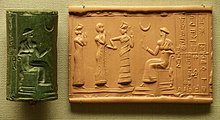21st century BC
Appearance
(Redirected from 2018 BC)
| Millennium |
|---|
| 3rd millennium BC |
| Centuries |
| Timelines |
| State leaders |
|
| Decades |
|
| Categories: |
|
Births – Deaths Establishments – Disestablishments |
The 21st century BC was a century that lasted from the year 2100 BC to 2001 BC.
Events
[edit]
All dates from this long ago should be regarded as either approximate or conjectural; there are no absolutely certain dates, and multiple competing reconstructed chronologies, for this time period.
- c. 2150–2040 BC – The First Intermediate Period of Egypt, a period of decline in Egyptian central power.[1]
- c. 2112–2004 BC – The Third Dynasty of Ur.[2] The Ziggurat of Ur is built. Administrative power in Ur is pushed far, with an Ensi, an appointed civil servant, at the head of the constituencies. A meticulous and finicky bureaucracy manages, counts and controls the whole administration, which is as much concerned with the economy as with war or the service of the gods. The weight of such an administration arguably contributes to the collapse of the empire. Finally, the Elamites sack Ur and the third dynasty comes to an end.[3]
- c. 2100–2000 BC:
- Epic poetry is written in the Sumerian language, including the Epic of Gilgamesh.[4]
- In Chalcolithic Europe, the two circles of bluestones that form the inner part of Stonehenge are erected.[5]
- Shahr-e Sukhteh, "The Burnt City" in Persia, is abandoned.[6]
- c. 2100–1900 BC: The beginning of the Middle Minoan civilization in Crete.[7] Bronze metallurgy and the potter's wheel are introduced,[8] as are Cretan hieroglyphs.[9]
- c. 2100–1800 BC – The Sintashta culture emerges in the northern Eurasian Steppe.[10]
- c. 2070 BC – Yu the Great establishes the Xia dynasty in China.[11]
- c. 2050 BC – The beginning of the Middle Kerma culture in Upper Nubia.[12]
- Late spring 2049 BC – Seahenge is built in Britain.[13]
- c. 2040 BC – Mentuhotep II, ruler of the Eleventh Dynasty of Egypt in Thebes, completes the reunification of Egypt following his victory over the pharaohs of Herakleopolis, which marks the beginning of the Middle Kingdom.[14]
- c. 2000 BC – The earliest bronze age artifacts in Southeast Asia found in the Ban Chiang site in Thailand indicate the absence of a militaristic or urbanized state.[15]
References
[edit]Wikimedia Commons has media related to 21st century BC.
- ^ O'Neill, John P. (1999). Egyptian Art in the Age of the Pyramids. Metropolitan Museum of Art. p. 20. ISBN 978-0-87099-907-9.
- ^ Roux, Georges (1995). La Mésopotamie. Seuil. p. 189. ISBN 978-2-02-008632-5.
- ^ Margueron, Jean-Claude (2012). Le Proche-Orient et l'Égypte antiques. Hachette Éducation Technique. p. 174. ISBN 978-2-01-140096-3.
- ^ Papin, Yves Denis (1998). Chronologie de l'histoire ancienne. Jean-paul Gisserot. p. 8. ISBN 978-2-87747-346-0.
- ^ Azéma, Marc; Brasier, Laurent (2016). Le beau livre de la préhistoire. Dunod. p. 371. ISBN 978-2-10-075789-3.
- ^ Foltz, Richard C. (2016). Iran in World History. Oxford University Press. p. 6. ISBN 978-0-19-933550-3.
- ^ Protopsaltis, Demetrios (2012). An Encyclopedic Chronology of Greece and Its History. Xlibris Corporation. p. 37. ISBN 978-1-4691-3999-9.
- ^ Tulard, Jean (1978). Histoire de la Crète. Que sais-je ?. p. 72. ISBN 978-2-13-065663-0.
- ^ Pichot, André (2014). La naissance de la science. Vol. 2. Gallimard. p. 15. ISBN 978-2-07-253206-1.
- ^ Hanks, Bryan K.; Linduff, Katheryn M. (2009). Social Complexity in Prehistoric Eurasia. Cambridge University Press. p. 47. ISBN 978-0-521-51712-6.
- ^ Mungello, David E. (2009). The Great Encounter of China and the West, 1500–1800 (3 ed.). Rowman & Littlefield. p. 97. ISBN 9780742557987.
- ^ Edwards, David N. (2004). The Nubian Past. Routledge. p. 81. ISBN 978-1-134-20087-0.
- ^ Based on tree felling date. "The art of Seahenge". The British Museum. Retrieved 2023-10-08.
- ^ Grimal, Nicolas (1988). Histoire de l'Égypte ancienne. Fayard. p. 194. ISBN 978-2-213-64001-3.
- ^ "White, J.C. 2008 Dating Early Bronze at Ban Chiang, Thailand. In From Homo erectus to the Living Traditions. Pautreau, J.-P.; Coupey, A.-S.; Zeitoun, V.; Rambault, E., editors. European Association of Southeast Asian Archaeologists, Chiang Mai, pp. 91-104" (PDF). Archived from the original (PDF) on 2017-08-08. Retrieved 2012-04-24.
